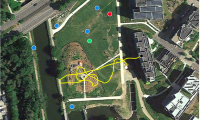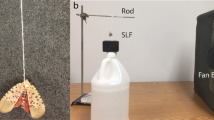Summary
The three-dimensional flight paths of male Fannia canicularis underneath prominent indoor landmarks were filmed and reconstructed for analysis. The flies patrol well-defined airspaces (of about 50x50 cm horizontal, 25 cm vertical extent) underneath landmarks like lampshades. Their flight paths have a distinct structure: they fly straight for on average 400 ms and an average distance of 20 cm; they change flight direction by abruptly turning through on average 95° and continue to fly straight. the sign of changes in flight direction is kept constant for periods of 2–20 s and changed at irregular intervals. Male flies approach a landmark from below and, in the absence of other flies, settle to patrol an airspace close to the landmark. A second male approaching the same landmark chases, or is chased away by, the patrolling fly when it comes too close and may eventually settle to patrol 10–30 cm below the airspace occupied by the first fly. A dummy fly presented to a patrolling fly between the airspace he patrols and the landmark is vigorously attacked from below and prevents the fly from regaining his former patrolling station. By trapping flies on sticky ribbons suspended from the ceiling, which served as landmarks, it can be shown that males and females approach and land on landmarks. It is suggested that male flies establish a lek-type mating assembly underneath landmarks to intercept approaching females. The position of male patrolling stations relative to the landmark suggests that females might arrive at landmarks from the side (and not from below, as males do), thus crossing the dorsal visual field of patrolling males.
Similar content being viewed by others
References
Baker RR (1983) Insect territoriality. Annu Rev Entomol 28:65–89
Beersma DGM, Stavenga DG, Kuiper JW (1977) Retinal lattice, visual field and binocularities in flies. J Comp Physiol 119:207–220
Collett TS, Land MF (1975a) Visual control of flight behaviour in the hoverfly Syritta pipiens L. J Comp Physiol 99:1–66
Collett TS, Land MF (1975b) Visual spatial memory in a hoverfly. J Comp Physiol 100:59–84
Collett TS, Land MF (1978) How hoverflies compute interception courses. J Comp Physiol 125:191–204
Colyer CN, Hammond CO (1951) Flies of the British Isles. Warner, London
Dahmen H-J, Zeil J (1984) Recording and reconstructing threedimensional trajectories: a versatile method for the field biologist. Proc R Soc Lond B222:107–113
Downes JA (1969) The swarming and mating flight of diptera. Annu Rev Endomol 14:271–298
Franceschini N (1984) Chromatic organisation and sexual dimorphism of the fly retinal mosaic. In: Borsellino A, Cervetto L (eds) Photoreceptors Plenum Press New York, pp 319–350
Gruhl K (1924) Paarungsgewohnheiten der Dipteren. Z Wiss Zool 122:205–280
Land MF, Collett TS (1974) Chasing behaviour of houseflies (Fannia canicularis). J Comp Physiol 89:331–357
Land MF, Eckert H (1985) Maps of the acute zones of fly eyes. J Comp Physiol 156:525–538
Pajunen VI (1980) A note on the connexion between swarming and territorial behaviour in insects. Ann Entomol Fenn 46:53–55
Pajunen VI (1982) Swarming behaviour in Ophyra leucostoma Wied. (Diptera, Muscidae). Ann Zool Fenn 19:81–85
Sullivan RT (1981) Insect swarming and mating. Fla Entomol 64:44–65
Thornhill R (1980) Sexual selection within mating swarms of the lovebug, Plecia nearctica (Diptera: Bibionidae). Anim Behav 28:405–412
Thornhill R, Alcock J (1983) The evolution of insect mating systems. Harvard University Press, Cambridge Mass, London
Wehrhahn C (1979) Sex-specific differences in the chasing behaviour of houseflies (Musca). Biol Cybern 32:239–241
Wehrhahn C, Poggio T, Bülthoff H (1982) Tracking and chasing in houseflies (Musca). Biol Cybern 45:123–130
Wenk P (1965) Über die Biologie blutsaugender Simuliiden (Diptera) II. Schwarmverhalten, Geschlechterfindung und Kopulation. Z Morphol Ökol Tiere 55:671–713
Zeil J (1983 a) Sexual dimorphism in the visual system of flies: The compound eyes and neural superposition in Bibionidae (Diptera). J Comp Physiol 150:379–393
Zeil J (1983 b) Sexual dimorphism in the visual system of flies: The free flight behaviour of male Bibionidae (Diptera). J Comp Physiol 150:395–412
Author information
Authors and Affiliations
Rights and permissions
About this article
Cite this article
Zeil, J. The territorial flight of male houseflies (Fannia canicularis L.). Behav Ecol Sociobiol 19, 213–219 (1986). https://doi.org/10.1007/BF00300862
Received:
Accepted:
Issue Date:
DOI: https://doi.org/10.1007/BF00300862




